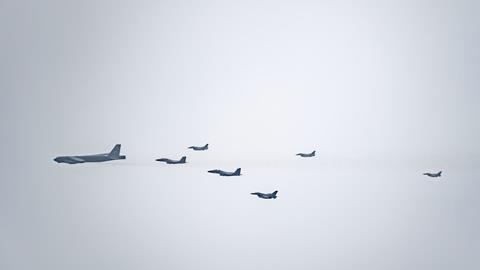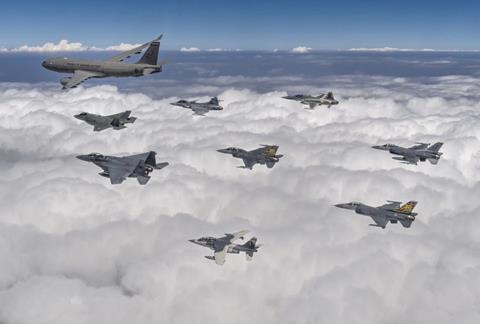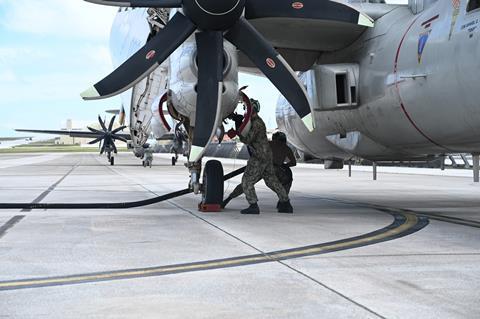The US Air Force (USAF) has conducted several activities in the Asia-Pacific that emphasise joint operations between allies and military services.
On 2 April, a pair of USAF Boeing B-52 bombers were escorted at an undisclosed location by a trilateral force comprised of USAF Lockheed Martin F-16s, Japan Air Self-Defence Force Mitsubishi F-2s, and Republic of Korea Air Force Boeing F-15Ks.

This is the third time fighters from the three defence forces have operated together since a summit between the leaders of the three countries met at the US presidential retreat of Camp David, Maryland in late 2023.
Traditionally, the militaries of Japan and South Korea have been wary towards each other, but persistent military threats from North Korea and China have prompted them to collaborate more closely.
“The enhanced complexity and fluidity of our collective forces demonstrate the strength of the partnership and cooperation between the three countries, keeping with commitments made to regularise defensive exercise and increase readiness,” says the US Indo-Pacific Command.
“Our commitment underscores the shared vision for a secure, rules-based, and open Indo-Pacific region.”
The USAF has also wrapped up the Cope Tiger exercise in Thailand, where USAF Lockheed F-35As and other aircraft conducted air combat training with various assets from the Republic of Singapore Air Force, including F-15SGs and F-16C/Ds, alongside the Royal Thai Air Force, which deployed a range of types, including the Saab Gripen C/D and Northrop F-5T.

The USAF’s Andersen AFB in Guam also worked recently with the US Navy (USN) to practice ‘hot refuelling’ with a Northrop Grumman E-2D Hawkeye, the airborne early warning and control (AEW&C) aircraft deployed aboard USN aircraft carriers.
‘Hot refuelling’ sees an aircraft refuelled while its engines are still running, decreasing time spent on the ground.

The USAF is gearing up for another exercise, Cope Thunder 24-1, in the Philippines. The exercise originated in the Philippines in 1976, but then was transferred to Alaska in 1992, when US forces departed the Philippines.
“Resuming in the Philippines in 2023, this exercise offers a distinctive platform to integrate forces and enhance interoperability between the Philippine and United States air forces,” says Pacific Air Forces.
Separately, a Boeing E-7A Wedgetail AEW&C aircraft of the Royal Australian Air Force (RAAF) returned to Australia after a six-month deployment to Europe, where it provided early warning for potential threats from Russia outside of Ukraine.
About 100 RAAF personnel were involved in the deployment, with the E-7A flying around 250h, with average missions averaging 5h in the air.


























